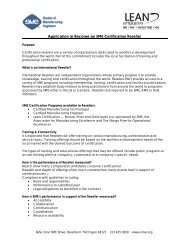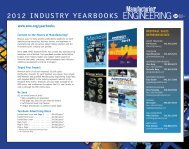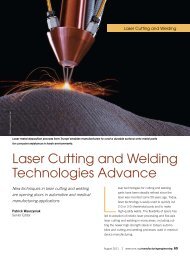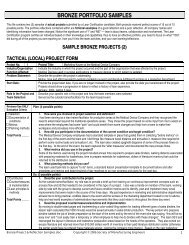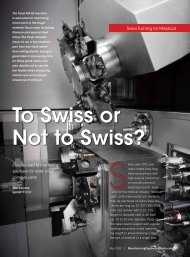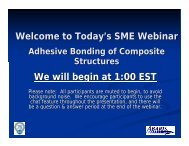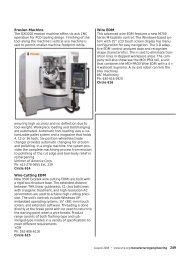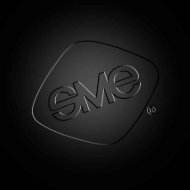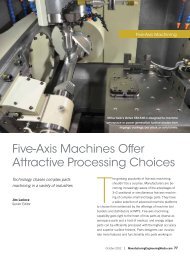Buckypaper: - Society of Manufacturing Engineers
Buckypaper: - Society of Manufacturing Engineers
Buckypaper: - Society of Manufacturing Engineers
- No tags were found...
You also want an ePaper? Increase the reach of your titles
YUMPU automatically turns print PDFs into web optimized ePapers that Google loves.
Aerospace Materialsmetal mesh currently used in the structure <strong>of</strong> the compositeaircraft to disperse lightning strikes, buckypaper, with itshigh current-carrying capacity, would allow lightning’s electricalcharge to flow around the plane and dissipate withoutcausing damage.Furthermore, buckypaper is flame retardant and could oneday help prevent fires on aircraft, ships and other structures.Its strength-to-weight ratio might also prove ideal when makingprotective gear, including helmets and body armor, for themilitary and police, as well as create improved, more comfortableprosthetics for wounded veterans. Such features explainwhy the US Air Force and companies including Raytheon andLockheed Martin have been investing in R&D efforts aimed atgetting the material to fulfill its promise.Florida State University’s High-Performance Materials Institute(HPMI; Tallahassee), where C 60co-discoverer and NobelLaureate Harold Kroto serves as senior science advisor—ispaving the way when it comes to narrowing the gap betweenresearch and the practical use <strong>of</strong> buckypaper. Nobel LaureateRichard Smalley first produced buckypaper during the1990s by filtering a nanotube suspension in order to preparesamples for various tests. HPMI has spent the past severalyears building upon this work, making buckypapers larger andmore multifunctional for composite fabrication and achievingseveral patents for its efforts.Composites Dominate inAero Materials ResearchWhile research on buckypaper continues, other materials also havethe aerospace industry’s attention. Titanium, aluminum and high-nickelalloys such as Inconel will continue to hold interest, but the lion’s share<strong>of</strong> aerospace materials-related R&D is being done with composites,according to George N. Bullen, president and CEO <strong>of</strong> Smart Blades Inc.(Oxnard, CA).“By far, the largest investment in change to materials, materialsbaselines, and materials processes has been in composite materials,”Bullen recently told ME. He noted four primary areas where the nextstage <strong>of</strong> incorporation can become cost effective to leverage the advantages<strong>of</strong> composite structures into large aero structures:Elimination <strong>of</strong> the autoclave for the cure <strong>of</strong> autoclave-cured materials.One method recently demonstrated successfully is In-A-Bag cureor degassing cure. If large composite structures can be cured usinghigh-strength autoclave cure materials, out <strong>of</strong> the autoclave, then thecost, complexity and limitations <strong>of</strong> installing and operating an autoclavewould be eliminated in the manufacturing process.Another approach is to bond large structures including substructuresinto a single unified piece <strong>of</strong> aero-substructure. If bondingtogether <strong>of</strong> large skins and a substructure can be achieved that result inthe same high-strength properties <strong>of</strong> a fastened aero-substructure, thensignificant cost and complexity would be reduced in the manufacturingprocess. There are currently major efforts to achieve this goal.If large unified structures can be achieved out <strong>of</strong> the autoclave,then methods and machines need to be and are being developed thatcan lay down large quantities <strong>of</strong> time-sensitive materials. When largestructures are manufactured using composites, tooling and materialhandling become challenges, which are being addressed, and will in thenear future migrate into the manufacturing process.InSitu inspection, test, and evaluation systems for large compositesstructures are under development. Small structures currently madeby hand are moved to the inspection areas for review after fabrication.As structures grow, they may be beyond the capability <strong>of</strong> factories tomove to inspection machines.92 <strong>Manufacturing</strong>EngineeringMedia.com | March 2013





